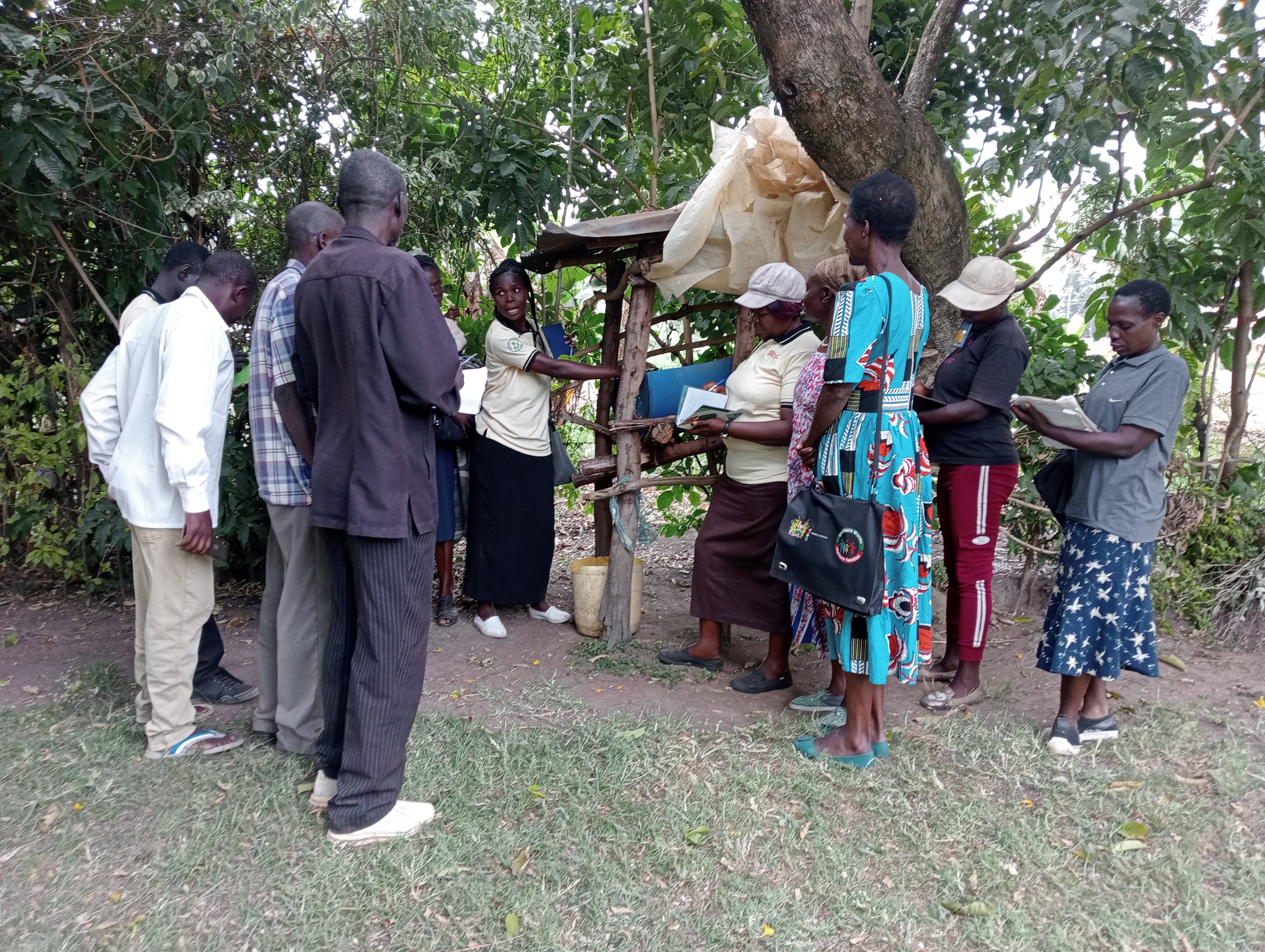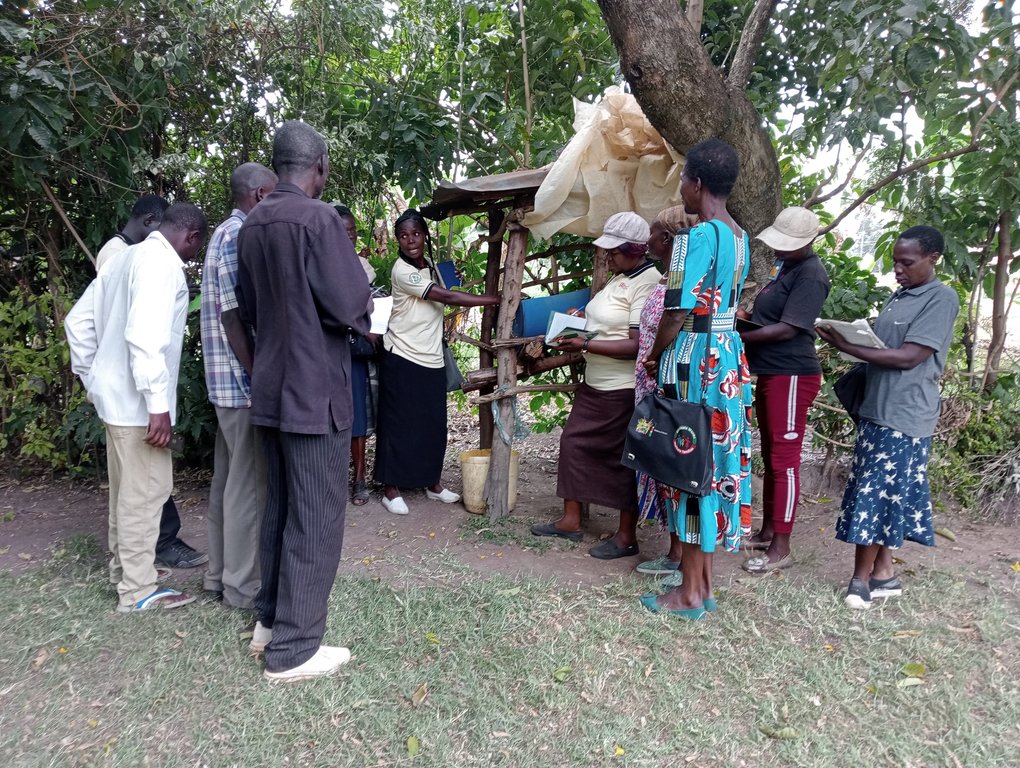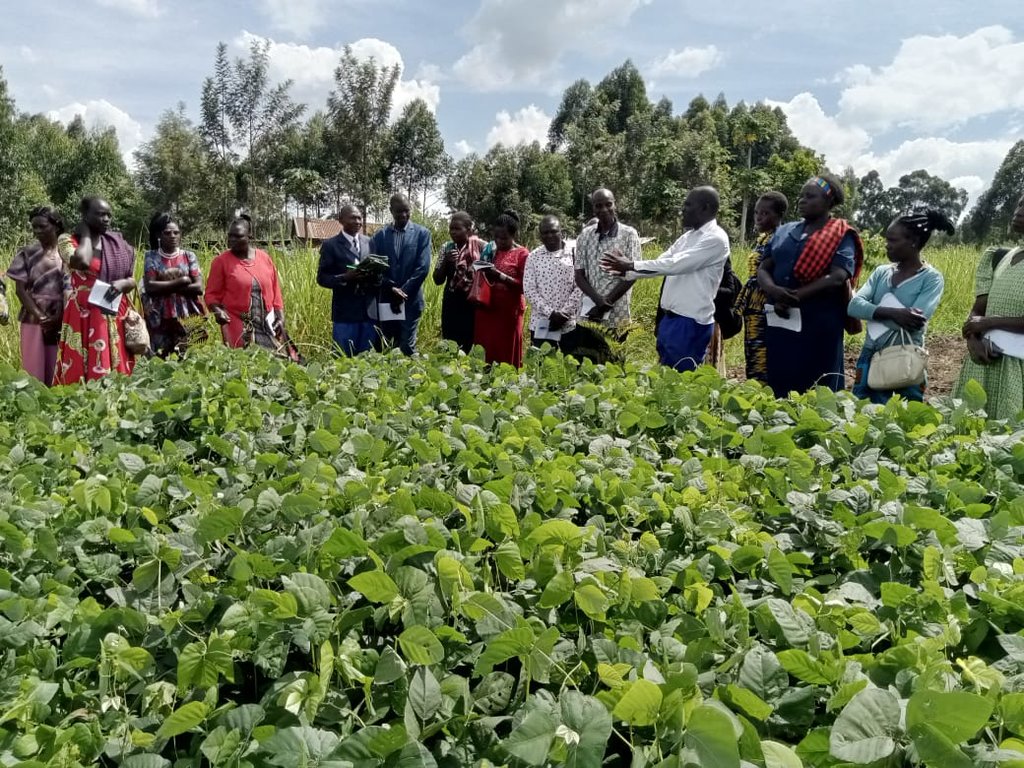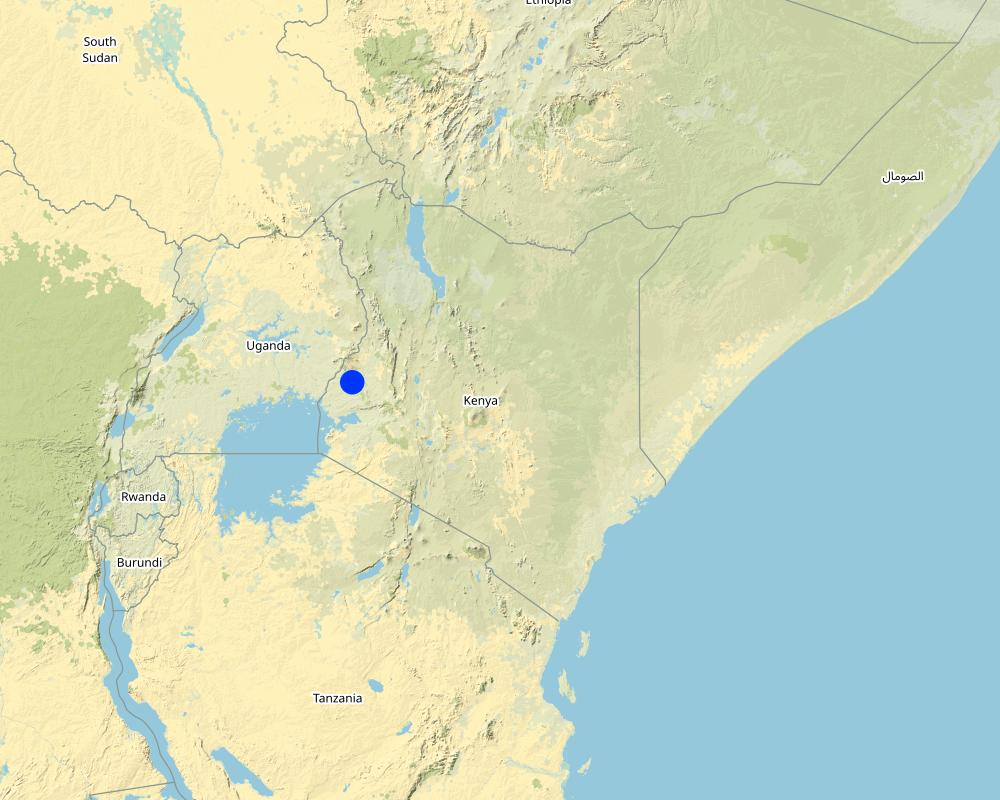Community Resource Persons (CRP) in agricultural extension [Кения]
- Создание:
- Обновить:
- Составитель: William Akwanyi
- Редакторы: Maureen Elegwa, Innocent Faith, Noel Templer
- Рецензенты: William Critchley, Rima Mekdaschi Studer
Mtu wa rasilimali za jamii/ Mkufunzi wa wakufunzi
approaches_6688 - Кения
Просмотреть разделы
Развернуть все Свернуть все1. Общая информация
1.2 Контактные данные специалистов и организаций, участвующих в описании и оценке Подхода
Ответственный (-ые) специалист (-ы)
Специалист по УЗП:
Nyanja Churchill
+254 710 849370
churchillwn2@gmail.com
Kimaeti Farmers Community-Based Organization (CBO)
Bukembe East Ward, Kanduyi Sub-county, Bungoma County
Кения
Специалист по УЗП:
Специалист по УЗП:
Название проекта, содействовавшего документированию/оценке Подхода (если применимо)
Soil protection and rehabilitation for food security (ProSo(i)l)Название организации (-ий), содействовавших документированию/оценке Подхода (если применимо)
Deutsche Gesellschaft für Internationale Zusammenarbeit (GIZ)Название организации (-ий), содействовавших документированию/оценке Подхода (если применимо)
Alliance Bioversity and International Center for Tropical Agriculture (Alliance Bioversity-CIAT) - Кения1.3 Условия, регламентирующие использование собранных ВОКАТ данных
Когда были собраны данные (на местах)?
03/02/2023
Составитель и ответственный/-ые специалист(-ы) согласны с условиями, регламентирующими использование собранных ВОКАТ данных:
Да
1.4 Ссылка (-и) на Анкету (-ы) по Технологиям УЗП
2. Описание Подхода УЗП
2.1 Краткое описание Подхода
Community Resource Persons (CRP) form a farmer-to-farmer learning approach that bridges the gap in agricultural extension, increases farmers' access to agricultural information (SLM knowledge), and increases the adoption of SLM practices.
2.2 Подробное описание Подхода
Подробное описание Подхода:
Community Resource Persons (CRPs) are farmers at the community-level who promote the adoption of SLM technologies by offering agricultural extension services. GIZ implements the ProSoil project in the Western Kenya counties of Kakamega, Siaya, and Bungoma through partners i.e., Welthungerhilfe (WHH) and Gesellschaft für Agrarprojekte in Übersee (GFA Consulting Group/ GFA). Further, these partners collaborate with other local non-governmental organizations (NGOs) and community-based organizations (CBOs) in the implementation of the project. Farmer groups belonging to local communities characterized by men, women, and youth are recruited by field officers from the implementing partners and trained in Sustainable Land Management (SLM) practices. The training is done by technical staff from the County Department of Agriculture. The implementing partners facilitate the trainings. The trained farmers (CRPs) are issued with certificates of recognition signed by GIZ ProSoil project manager, the head of the implementing partner, and the County Director of Agriculture at the County Department of Agriculture. These CBOs and farmer groups work closely with agricultural extension officers from the county departments of agriculture to disseminate different agricultural technologies and SLM measures. The aim of CRPs is to bridge the gap in agricultural extension by overcoming the problem of low extension staff-to-farmer ratios. The objective is to sustain the adoption of various SLM measures promoted by the project among the beneficiaries and non-project farmers.
In Bukembe East Ward, Bungoma County, GFA collaborates with Kimaeti Farmers CBO to implement the Soil Protection and Rehabilitation of Degraded Soil for Food Security (ProSoil) project. Kimaeti Farmers CBO recruited agriculture field technicians who were then trained in SLM practices by GFA. The trained field technicians sensitize local communities in various operational areas about the project and recruit farmer groups: 25 farmers per group. Each field technician manages several groups per sub location and takes them through trainings and demonstrations on soil protection and rehabilitation technologies. Farmer groups are also trained on group organization development and management to enhance group cohesion. Each farmers group selects 3 CRPs who undergo specialized training to equip them with more skills and expertise to follow up, mentor and coach fellow farmers. These CRPs also monitor implementation of various technologies, gather farmer feedback, and even reach out to other farmers in the community not reached by the project. This extension service is usually done voluntarily. However, some farmers reward the CRPs for the advisory services in cash or kind. In some cases, CRPs who are specialised in some SLM technologies e.g., construction of structures for vermicomposting become co-trainers and may enter into contractual agreements with GIZ, GFA, or any other institution that wants their services. In this case, they are paid as agreed on the contracts.
Each CRP manages a cluster of 5–7 farmers. They also reach out to farmers within their respective communities according to consultatively agreed calendars/timeframes. Every available opportunity is used by CRPs to spread SLM knowledge, including meeting farmers at their farms; convening farmers at common locations within their communities where they talk to them about SLM; farmer field days organised by the implementing partners, or the county department of agriculture, etc. Hence, CRPs attract the attention of many farmers, including those who are direct beneficiaries of the ProSoil project and those who are not direct beneficiaries. CRPs are thus important in improving farmers' access to agricultural information at little or no cost since CRPs work on a voluntary basis.
The CRP approach has been successful in bringing together female and male, and youthful, middle-aged, and elderly farmers of different socio-cultural and economic backgrounds on issues of common interest i.e., SLM, household food security, and economic empowerment. This has enhanced communication, built social solidarity, and enhanced social cohesion among the farmers.
2.3 Фотографии, иллюстрирующие Подход
2.5 Страна/ регион/ место, где применялся Подход
Страна:
Кения
Административная единица (Район/Область):
Bungoma County in Western Kenya
Более точная привязка места:
Bukembe East Ward, Kanduyi Sub-county, Bungoma County
Map
×2.6 Даты начала и окончания реализации Подхода
Год начала реализации:
2021
Комментарии:
Farmers are still learning from each other through the CRP approach.
2.7 Тип Подхода
- в рамках проекта/ программы
2.8 Каковы цели/ задачи Подхода
Aim: To bridge the gap in agricultural extension.
Objectives:
1. To improve farmers' access to agricultural information.
2. To sustain the adoption of new technologies trained to the project beneficiaries and non-project farmers.
3. To overcome the problem of low extension staff-to-farmer ratio through farmer-to-farmer learning.
2.9 Условия содействующие применению Технологии/ Технологий в рамках Подхода или затрудняющие его
Социальные/ культурные/ религиозные нормы и ценности
- содействуют
1. General acceptance by the community.
2. Ability to bring together of different socio-cultural and economic backgrounds on issues of common interest i.e., SLM, household food security, and economic empowerment which has enhanced communication, built social solidarity, and enhanced social cohesion among community members.
Наличие/ доступность финансовых ресурсов и услуг
- затрудняют
CRPs work on voluntary basis; hence, may not be motivated to reach out to farmers in areas that are very far from their reach.
Институциональные условия
- содействуют
Availability and willingness of Kimaeti CBO to collaborate with GFA.
Сотрудничество/ координация действий
- содействуют
Linkages and partnerships among different organizations and institutions, including GIZ, GFA, Kimaeti CBO, etc. which expanded the outreach of the approach.
Нормативно-правовая база (землевладение, права на земле- и водопользование)
- содействуют
Access to farming land where farmers implement SLM technologies.
Управление земельными ресурсами (принятие решений, осуществление и контроль за выполнением)
- затрудняют
Women and youth farmers are limited in their access, use, and control of land. Hence, they may not be able to implement certain SLM technologies even if they gained knowledge about them through CRPs who are fellow farmers e.g., agroforestry.
Осведомленность в области УЗП, доступность технической поддержки
- содействуют
SLM knowledge among technical staff in the collaborating institutions and documented references.
Объем работ, доступность рабочей силы
- содействуют
CRPs from the communities who are willing to work with fellow farmers.
- затрудняют
Voluntary nature of the CRPs' support - CRPs are likely to sacrifice their own farmwork at the expense of the CRP work, something that may discourage them if they get poor harvest.
3. Участие и распределение ролей заинтересованных сторон
3.1 Заинтересованные стороны, участвующие в реализации Подхода и их роли
- местные землепользователи/ местные сообщества
Farmers - men, women, and youth.
Targeted by the technologies, they learn from other farmers, and implement the technologies.
- организации местных сообществ
Kimaeti Farmers Community-Based Organization
Has recruited a team of trained SLM specialists who pass the SLM knowledge to the community resource persons in the community.
- эксперты по УЗП/ сельскому хозяйству
SLM specialists from GIZ ProSoil project, GFA, and Kimaeti Farmers Community-Based Organization.
SLM specialists from GIZ ProSoil project - supported in the technical design of the approach.
SLM specialists from GFA - ProSoil implementing partner, trains the Community-Based Organizations that implement the approach.
SLM specialists from Kimaeti Farmers Community-Based Organization - pass the SLM knowledge to the community resource persons in the community.
- местные власти
Agricultural extension officers from the county government department of agriculture.
Work hand-in-hand with SLM specialists to pass the SLM knowledge to the farmers.
- международные организации
GIZ
Proposal design and financial support to the implementation of the approach.
Если участвовало несколько заинтересованных сторон, назовите ведущую организацию:
GIZ
3.2 Участие местных землепользователей/ местных сообществ на разных стадиях реализации Подхода
| Участие местных землепользователей/ местных сообществ | Перечислите участников и опишите их вовлеченность | |
|---|---|---|
| инициирование/ мотивация | пассивное | Farmers in the community, targeted by the SLM technologies, they implement the technologies. |
| планирование | интерактивное | Community resource persons and other farmers in the community jointly agree on when to engage each other, especially time and venue for capacity building. |
| выполнение | интерактивное | Based on the status of the farmers, including land size, available capital, status of land degradation, etc. community resource persons and other farmers decide which SLM technologies are best for each farm. |
| мониторинг/ оценка | пассивное | The planning for and conduct of monitoring and/ or evaluation is a role of GIZ and WHH. Farmers are mainly interviewed based on pre-determined questions. |
| Research | нет |
3.3 Схема реализации (если имеется)
Описание:
The ProSoil Project (GIZ and GFA) provides financial resources for the training of CRPs. The CRPs are trained by SLM specialists from the County Department of Agriculture. The CRPs provide advisory services to farmers.
Автор:
William Akwanyi
3.4 Принятие решений по выбору Технологии/ Технологий УЗП
Укажите, кто принимал решение по выбору применяемой Технологии/ Технологий:
- в основном землепользователи при поддержке специалистов по УЗП
Поясните:
Decisions on what SLM technologies to implement were made mainly by farmers supported by SLM specialists from GIZ ProSoil project, GFA, and Kimaeti Farmers Community-Based Organization.
Поясните на чём было основано принятие решений:
- анализ подробно описанного опыта и знаний по УЗП (принятие решений на основе подтвержденных фактов)
- личный опыт и мнения (незадокументированные)
4. Техническая поддержка, повышение компетенций и управление знаниями
4.1 Повышение компетенций/ обучение
Проводилось ли обучение землепользователей/ других заинтересованных лиц?
Да
Укажите, кто проходил обучение:
- землепользователи
- местный персонал/консультанты
Если существенно, укажите гендерный и возрастной состав, статус, этническую принадлежность и т.д.
CRPs from each village of about 25 farmers
Тип обучения:
- в ходе работы
- обмен опытом между фермерами
- опытные участки
Рассматриваемые темы:
1. Conservation Agriculture
2. Agroforestry
3. Soil and Water Conservation measures
4. Integrated Soil Fertility and Pest Management (ISF&PM)
5. Push-pull
6. Good Agronomic Practices
Комментарии:
GFA trained/ trains Kimaeti Farmers CBO field technicians in SLM. The trained technicians then train the CRPs.
4.2 Консультационные услуги
Есть ли у землепользователей возможность получать консультации?
Да
Укажите, где именно оказываются консультационные услуги:
- на полях землепользователей
- в постоянно функционирующих центрах
Описание/ комментарий:
CRPs advise farmers at their farms whenever they visit them. Meetings are held on needs basis between farmers and the CRPs where pieces of advice are given to farmers.
4.3 Институциональная (организационная) поддержка
В ходе реализации Подхода были ли организованы новые институциональные структуры или поддержаны уже существующие?
- да, существенно
Укажите уровень, на котором структуры были укреплены или вновь созданы:
- местные
Опишите организацию, функции и ответственность, членство и т.д.
Kimaeti Farmers CBOs and farmer groups at community level whose member farmers are capacity build and are able to learn from each other.
Укажите тип поддержки:
- повышение компетенций/ обучение
Подробнее:
Kimaeti Farmers CBO technical officers have been trained in SLM practices.
4.4 Мониторинг и оценка
Являются ли мониторинг и оценка частью Подхода?
Да
Комментарии:
GIZ and GFA regularly follows up with farmers to check on the implementation of technologies promoted under this approach.
Если да, будет ли данный документ использоваться для мониторинга и оценки?
Нет
Комментарии:
This documentation in intended for keeping a record of SLM technologies and approaches.
4.5 Научные исследования
Были ли научные исследования частью Подхода?
Нет
5. Финансирование и внешняя материальная поддержка
5.1 Годовой бюджет мероприятий по УЗП в рамках Подхода
Если точный годовой бюжет неизвестен, укажите примерный диапазон затрат:
- 10000-100000
Комментарий (например, основные источники финансирования/ ключевые доноры):
Training costs for training 25 CRPs met by GIZ through GFA.
5.2 Финансирование и внешняя материальная поддержка, предоставляемая землепользователям
Предоставлялась ли землепользователям финансовая/ материальная поддержка для применения Технологии /Технологий?
Нет
5.3 Субсидии на отдельные затраты (включая оплату труда)
- нет
Комментарии:
No labour was provided by land users.
5.4 Кредитование
Предоставлялись ли в рамках Подхода кредиты на мероприятия УЗП?
Нет
5.5 Другие методы или инструменты стимулирования
Использовались ли другие методы или инструменты стимулирования для продвижения Технологий УЗП?
Да
Если да, поясните:
Value addition to promote marketability of farm produce e.g., mucuna. This encouraged farmers to grow mucuna as a green manure cover crop.
6. Анализ влияния и заключительные положения
6.1 Влияние Подхода
Сумел ли Подход дать возможность принимать решения на основе подтвержденных фактов?
- Нет
- Да, немного
- Да, умеренно
- Да, существенно
Farmers were motivated to implement the SLM technologies that they were trained on by the CRPs, especially having seen how the CRPs had benefited from the SLM practices.
Сумел ли Подход помочь землепользователям внедрить и поддерживать технологии УЗП?
- Нет
- Да, немного
- Да, умеренно
- Да, существенно
The CRPs reached out to the land users/ farmers and taught them how to implement the SLM technologies.
Сумел ли Подход улучшить согласованность действий и повысить рентабельность применения практик УЗП:
- Нет
- Да, немного
- Да, умеренно
- Да, существенно
Farmers are not paying for the extension services that they receive from the CRPs.
Сумел ли Подход мобилизовать/ расширить доступ к финансовым ресурсам для применения практик УЗП?
- Нет
- Да, немного
- Да, умеренно
- Да, существенно
Сумел ли Подход расширить знания и возможности землепользователей в применении практик УЗП?
- Нет
- Да, немного
- Да, умеренно
- Да, существенно
SLM knowledge received from the CRPs.
Сумел ли Подход укрепить сотрудничество между заинтересоваными сторонами/ выстроить механизмы сотрудничества?
- Нет
- Да, немного
- Да, умеренно
- Да, существенно
Collaboration of GFA and GIZ, GFA and Kimaeti Farmers CBO strengthened.
Сумел ли Подход расширить возможности социально и экономически уязвимых групп?
- Нет
- Да, немного
- Да, умеренно
- Да, существенно
Farmers with limited resources to invest in capacity building/ training received free SLM knowledge.
6.2 Основные причины, побуждающие землепользователей внедрять УЗП
- рост продуктивности
Farmers harvested more after implementing the SLM technologies than when they were not implementing the technologies.
- снижение деградации земель
Most promoted SLM practices reduced degradation of farmlands e.g., soil and water conservation measures.
- престиж, общественное давление/ солидарность
Farmers of diverse social and economic statuses could meet for a common goal of learning about SLM.
- приобретение знаний и опыта в области УЗП
Farmers received training about SLM from the CRPs.
- снижение остроты конфликтов
CRPs are able to solve conflicts that arise within the groups
6.3 Долгосрочная устойчивость мероприятий в рамках Подхода
Могут ли землепользователи самостоятельно (без внешней поддержки) продолжать применение того, что было реализовано в рамках Подхода?
- да
Если да, опишите как:
Most of the SLM practices promoted under the approach have greatly improved the farms. Hence, a motivation to continue implementing even without donor support.
6.4 Сильные стороны/ преимущества Подхода
| Сильные стороны/ преимущества/ возможности по мнению землепользователей |
|---|
| Easy access to CRPs since they are members of the same communities with the target farmers. |
| Evidence-based learning from fellow farmers is a motivation for farmers to invest in SLM. |
| It could be a source of income for the CRPs; some earn an income by providing extension services to other farmers |
| Сильные стороны/ преимущества/ возможности по мнению составителя или других ключевых специалистов |
|---|
| A cost-effective method of disseminating agricultural information. |
6.5 Слабые стороны/ недостатки Подхода и пути их преодоления
| Слабые стороны/ недостатки/ риски по мнению землепользователей | Возможные пути их преодоления/снижения? |
|---|---|
| CRPs may lack resources to reach out to farmers since they work on voluntary basis. | Formal recognition of CRPs by the government of Kenya. Government setting aside some funds to support the CRPs |
| Resistance from some farmers. | CRPs to be provided with some form of identification, |
7. Справочные материалы и ссылки
7.1 Методы сбора/источники информации
- выезды на места, полевые обследования
One field visit involving demonstration of how CRPs interact with farmers.
- опросы землепользователей
Discussion with a CRP group
- опросы специалистов/экспертов по УЗП
Interview with GFA and Kimaeti CBO SLM specialist and several follow-up calls.
7.3 Ссылки на материалы, доступные онлайн
Название/ описание:
Training Community Resource Persons and Panchayat members in Tamil Nadu
Адрес в сети Интернет:
https://indo-germanbiodiversity.com/project-details-265.html
Ссылки и модули
Развернуть все Свернуть всеСсылки
Нет ссылок
Модули
Нет модулей






